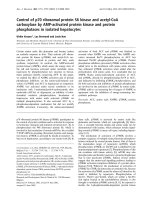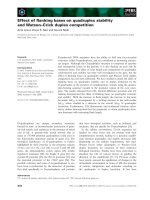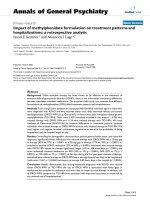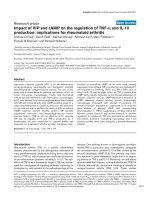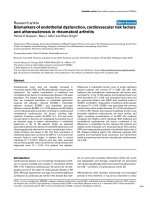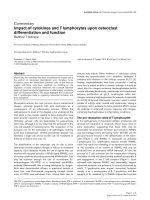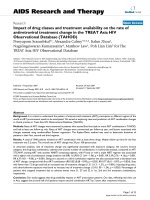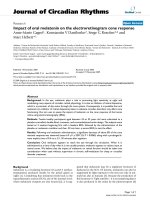Báo cáo y học: "Impact of methylphenidate formulation on treatment patterns and hospitalizations: a retrospective analysis" pptx
Bạn đang xem bản rút gọn của tài liệu. Xem và tải ngay bản đầy đủ của tài liệu tại đây (254.68 KB, 8 trang )
BioMed Central
Page 1 of 8
(page number not for citation purposes)
Annals of General Psychiatry
Open Access
Primary research
Impact of methylphenidate formulation on treatment patterns and
hospitalizations: a retrospective analysis
Jason E Kemner
1
and Maureen J Lage*
2
Address:
1
Associate Director Outcomes Research, McNeil Consumer and Specialty Pharmaceuticals, Fort Washington PA 19034, USA and
2
Managing Member, HealthMetrics Outcomes Research, Groton CT, USA
Email: Jason E Kemner - ; Maureen J Lage* -
* Corresponding author
Abstract
Background: While stimulant therapy has been shown to be effective in the treatment of
attention-deficit/hyperactivity disorder (ADHD), there is less information concerning differences
between alternative stimulant medications. The purpose of this study is to examine how different
formulations of methylphenidate (MPH) affect treatment patterns and hospitalizations.
Methods: From a large claims database we retrospectively identified individuals age 6 or older who
were diagnosed with ADHD and who received either once daily, extended-release oral system
methylphenidate (OROS
®
MPH) (e.g., Concerta
®
) or three-times daily immediate-release generic
methylphenidate (TID MPH). There were 5,939 individuals included in the analysis – 4,785 who
initiated therapy with OROS MPH and 1,154 who initiated therapy with TID MPH. We used
Analyses of Covariance (ANCOVAs) to examine differences in treatment patterns between
individuals who initiated therapy on OROS MPH and those who initiated therapy on TID MPH. We
used logistic and negative binomial multivariate regressions to examine the probability of being
hospitalized and the hospital length of stay.
Results: Controlling for demographic characteristics, patient general health status, and comorbid
diagnoses, significantly fewer individuals who initiated therapy with OROS MPH had a 15-day gap
in therapy (85% vs. 97%, p < 0.0001 or a 30-day gap in therapy (77% vs. 95%, p < 0.0001) or
switched to another ADHD medication (27% vs. 68%, p < 0.0001). Individuals who initiated therapy
with OROS MPH stayed on therapy significantly longer (199 vs. 108 mean days, p < 0.0001) and
more individuals received medication for 90% (24% vs. 5%, p < 0.0001), 80% (29% vs. 7%, p <
0.0001), or 75% (30% vs. 7%, p < 0.0001) of the days during the first year post initiation of therapy.
Individuals who initiated therapy on OROS MPH were also significantly less likely to be hospitalized
(odds ratio = 0.67, p = 0.0454) and stayed, on average, 0.69 fewer days in the hospital (p = 0.0035).
Conclusion: Results demonstrate that among individuals diagnosed with ADHD who receive
either OROS MPH or TID MPH, the use of OROS MPH is associated with fewer gaps in
medication, less switches in medication, and more days on intent-to-treat therapy. In addition, use
of OROS MPH compared to TID MPH was associated with improved outcomes, as measured by
the reduced use of hospitalizations.
Published: 10 April 2006
Annals of General Psychiatry2006, 5:5 doi:10.1186/1744-859X-5-5
Received: 06 May 2005
Accepted: 10 April 2006
This article is available from: />© 2006Kemner and Lage; licensee BioMed Central Ltd.
This is an Open Access article distributed under the terms of the Creative Commons Attribution License ( />),
which permits unrestricted use, distribution, and reproduction in any medium, provided the original work is properly cited.
Annals of General Psychiatry 2006, 5:5 />Page 2 of 8
(page number not for citation purposes)
Background
ADHD is one of the most frequently diagnosed childhood
mental health conditions, with a prevalence of 8–10% in
school age children[1]. Children diagnosed with ADHD
can suffer from academic impairments, social dysfunc-
tion, and a higher risk of both cigarette smoking and sub-
stance abuse [2,3]. In addition, Rowe, Maughan, and
Goodman (2004) found children or adolescents diag-
nosed with ADHD to be more likely to have unintentional
injuries [4] , while other research has found young adults
diagnosed with ADHD to be at increased risk for driving
accidents [5-7].
Although ADHD is typically thought of as a childhood
condition, it has been estimated that the condition per-
sists into adulthood for 10–60% of individuals who were
diagnosed as children [8,9]. As with the childhood popu-
lation, there are significant costs associated with ADHD in
the adult population. Specifically, adults with ADHD
have been found to have larger medical costs [10] , less
education [11] and higher rates of incarceration [12]. In
addition, adults with ADHD are less likely to be employed
[13,14] , while those employed are more likely to perform
poorly, change employment, or quit their jobs [15,16].
Most commonly, stimulants are prescribed as first-line
therapy for ADHD, with the American Academy of Pediat-
rics ADHD treatment guidelines stating that there is
strong evidence for the use of stimulant medication [17].
While stimulant therapy has been shown to be effective in
general [18,19] , the overall effectiveness of therapy also
depends upon patient adherence. For example, Charach,
Ickowicz, and Schachar (2004) examined adherence to
stimulants over a 5 year period and found that, after five
years, adherents showed greater improvement in teacher-
reported symptoms than those off medications or those
non-adherent to medication [18].
While stimulant therapy has been shown to be effective,
there is less information concerning differences between
the various stimulant medication formulations. The pur-
pose of this research was to compare treatment patterns
and outcomes of individuals who initiated therapy on dif-
fering stimulant medication formulations. Specifically,
the analyses compared those who initiated therapy with
TID MPH and those who initiated therapy with OROS
MPH. At the outset, we hypothesized that the easier treat-
ment regimen associated with once-daily OROS MPH
would be associated with improved patient adherence
and improved patient outcomes compared to TID dosing
of immediate-release (IR) MPH. In this analysis, we meas-
ured patient outcomes by hospitalizations, a variable that
contains implications for service planning and relates to
injury rates.
Methods
Data for this analysis came from the Integrated Health
Care Information Services (IHCIS) National Managed
Care Benchmark Database. This fully de-identified,
HIPAA (Health Insurance Portability and Accountability
Act)-compliant database includes complete medical his-
tories for more than 17 million managed-care lives. Labo-
ratory results, hospitalization data, pharmacy data, and
complete mental health data are available from this data-
base, in addition to patient demographics. The data
undergoes a rigorous data quality review prior to its addi-
tion to the database and the data conforms to basic data
validity norms. The data spanned the period February 1,
2000 to December 31, 2002.
Patients were eligible for inclusion in the analysis if they
received a diagnosis of ADHD based upon International
Classification of Diseases, Ninth Revision (ICD-9) codes
of 314.00 or 314.01, and received either OROS MPH or
TID MPH. Patients' records were indexed six months
before and twelve months after first receiving the drug of
interest. In order to focus on ADHD, we excluded individ-
uals from the sample if they were diagnosed with bipolar
disorder (ICD-9 296.4x – 296.8x), schizophrenia
(295.xx), paranoia (297.xx), other psychotic disorders
(290.xx-294.xx, 296.24, 296.34, 296.9x), Alzheimer's
(331.0x), Parkinson's (332.xx), or mental retardation
(317.xx – 319.xx). We also excluded individuals from the
analysis if they received either OROS MPH or TID MPH in
the six-month pre-period. In addition, for eligibility, indi-
viduals had to be at least age 6 and have continuous insur-
ance coverage during the pre- and post-periods. There
were 5,939 individuals who met the above criteria – 4,785
who received OROS MPH and 1,154 who received TID
MPH.
The analysis focused on the differences in medication
usage patterns and hospitalizations between individuals
who initiated treatment with OROS MPH and those who
initiated treatment with TID MPH. We examined several
medication usage patterns, including gaps in therapy,
switches in ADHD medication, number of days on ther-
apy, and treatment adherence. We constructed two varia-
bles to capture gaps in therapy: Gap15 was defined as a 15-
day or greater gap between the end of one ADHD medica-
tion prescription and the start of the next ADHD medica-
tion prescription or cessation of ADHD medication prior
to 15 days before the end of the post-period of analysis;
and gap30 was defined analogously to gap15 but with 30-
day gaps in medication. We defined a switch as a cessation
of treatment on the initial ADHD medication (either
OROS MPH or TID MPH) and initiation of treatment with
an alternative ADHD medication (either the other intent-
to-treat medication or one of the following: twice-daily
methylphenidate, Ritalin™, Ritalin LA™, Adderall™, Adder-
Annals of General Psychiatry 2006, 5:5 />Page 3 of 8
(page number not for citation purposes)
all XR™, or Metadate CD™), while we defined switchitt as
cessation of treatment with OROS MPH and initiation of
treatment with TID MPH, or vice versa. Finally, we defined
adherence in terms of the number of days that the individ-
ual received the intent-to-treat (ITT) medication over the
365 day post-period, with adherence90, adherence80, and
adherence75 receiving the ITT medication for 90%, 80%,
and 75% of the post-period, respectively.
We used four classes of independent variables in this
study: demographic characteristics, patient general health
status, co-morbid diagnoses, and medication use. Patient
demographic characteristics consisted of the individuals'
age, sex, region, and type of insurance coverage. We prox-
ied patient general health status as the number of distinct
ICD-9 codes (based upon three digits) with which the
individual was diagnosed during the six month pre-
period. We based comorbidities upon an inpatient or out-
patient diagnosis and classified them using ICD-9 codes.
Previous research has found that individuals diagnosed
with ADHD may be more likely to have comorbid alcohol
or drug abuse (ICD-9 291.xx, 292.xx, 303.xx, 304.xx, or
305.xx), accidents or injuries (ICD-9 Exx.xx), and one or
more of the following mental illness diagnoses: anxiety
(ICD-9 300.00, 300.01, 300.02, 309.81, 300.2x or
300.3x), depression (ICD-9 of 296.2x, 206.3x, 300.4x,
309.0x, or 309.1x), or oppositional disorder (ICD-9
313.81) [5,10,20-24]. Finally, we hypothesized that dif-
ferences in ADHD medication, specifically the use of
once-daily OROS MPH compared to TID MPH, might
affect both medication treatment patterns and outcomes.
We examined treatment patterns using ANCOVAs that
controlled for all of the independent variables described
above. To examine factors which affect emergency room
visits among individuals diagnosed with ADHD, we con-
ducted two multivariate analyses. Specifically, we used a
logistic regression to examine the probability of being
hospitalized during the twelve-month post-period, while
we used a negative binomial regression for all patients to
estimate the hospital length of stay over the post-period.
As with the ANCOVA analyses, these multivariate regres-
sions controlled for demographic characteristics, patient
general health status, comorbid diagnoses, and the use of
alternative ADHD medications. We considered findings
of a p-value less than or equal to 0.05 to indicate statistical
significance. We conducted all analyses using SAS Version
8.1 [25].
Results
Table 1 presents the characteristics of the 5,939 individu-
als included in the analysis. Examining all individuals, the
average age was approximately 15 (range 6–65), with the
majority of individuals being 18 years of age or younger.
The population consisted of more males than females
(23% females), and the majority of individuals resided in
the East (74%). The most common diagnoses were acci-
dent or injury (7%) and oppositional disorder (4%). The
majority of individuals in the sample initiated therapy on
OROS MPH rather than TID MPH (81% OROS MPH).
Table 1 also presents the characteristics of the individuals
who initiated therapy on OROS MPH compared to those
Table 1: Descriptive Statistics
Variable Entire Sample OROS MPH TID MPH p Value
Demographics
Mean Age 14.81 (9.55) 14.37 (8.73) 16.62 (12.42) < 0.0001
Female 23.49% 23.64% 22.88% 0.5849
Region
East 73.60% 75.51% 65.58% < 0.0001
South 3.00% 2.95% 3.21% 0.6426
North Central 1.38% 1.42% 1.21% 0.5869
West 7.27% 5.02% 16.64% < 0.0001
HMO Insurance 35.65% 35.72% 35.37% 0.8185
General Health Status
Prior number of diagnoses 3.34 (2.91) 3.44 (2.87) 2.96 (3.09) < 0.0001
Diagnoses
Anxiety 0.96% 0.92% 1.13% 0.5174
Depression 1.20% 1.13% 1.47% 0.3336
Oppositional disorder 4.45% 4.56% 3.99% 0.3992
Drug/Alcohol abuse 1.63% 1.65% 1.56% 0.8263
Accident/Injury 7.32% 7.42% 6.93% 0.5690
Medication
Concerta 80.57% 100% 0% NA
Sample Size 5,939 4,785 1,154
Annals of General Psychiatry 2006, 5:5 />Page 4 of 8
(page number not for citation purposes)
individuals who initiated therapy on TID MPH. The
OROS MPH cohort was significantly younger (mean age
14 vs. 17; p < 0.0001), had more individuals residing in
the East (76% vs. 66%; p < 0.0001) and fewer individuals
residing in the West (5% vs. 17%; p < 0.0001). In addi-
tion, the OROS MPH group had a significantly higher
total number of diagnoses in the pre-period of analysis
(3.44 vs. 2.96; p < 0.0001), although there were no signif-
icant differences between the two groups with regards to
incidence of specific comorbid conditions associated with
ADHD. There was also no difference between the OROS
MPH and TID MPH groups with regards to gender
(female; 24% vs. 23%, p = 0.5849).
Table 2 illustrates differences in treatment patterns in the
OROS MPH and TID MPH cohorts. The mean length of
therapy for the OROS MPH cohort was 199 days, com-
pared to 107 days for the TID MPH cohort (p < 0.0001).
Compared to individuals who received TID MPH, more
individuals who initiated treatment with OROS MPH had
Table 2: Treatment Patterns – ANCOVA Analyses
Variable Mean OROS MPH Mean TID MPH Difference p Value 95% Confidence
Interval
15 day Gap in ITT
medication
0.85 0.97 0.11 <0.0001 0.0945 – 0.1366
30 day Gap in ITT
medication
0.77 0.95 0.17 < 0.0001 0.1510 – 0.2022
Switch to another
ADHD med
0.27 0.68 0.41 < 0.0001 0.3802 – 0.4394
Switch to other ITT
med
0.01 0.33 0.31 < 0.0001 0.2962 – 0.3271
Days on ITT
medication
199.09 107.73 -91.36 < 0.0001 -99.94 – -82.78
90% Compliant 0.24 0.05 -0.1818 < 0.0001 -0.2076 – -0.1560
80% Compliant 0.29 0.07 -0.2227 < 0.0001 -0.2503 – -0.1949
75% Compliant 0.30 0.05 -0.2274 < 0.0001 -0.2554 – -0.1995
ANCOVA results controlling for demographics, general health status, and diagnoses.
Table 3: Hospitalization – Multivariate Regression Analyses
Variable Dependent Variable – Hospitalization Logistic
Regression
Dependent Variable – Hospital Length of Stay
Negative Binomial Regression
Odds Ratio 95% Confidence
Interval
p Value Point Estimate 95% Confidence
Interval
p Value
Demographics
Age 1.017 1.002 – 1.033 0.0234 -0.024 -0.040 – -0.089 0.0019
Female 0.953 0.634 – 1.432 0.8162 0.325 -0.099 – 0.0750 0.1333
East 0.724 0.476 – 1.099 0.1294 -0.795 -1.289 – -0.201 0.0016
South 1.395 0.573 – 3.397 0.4635 -1.364 -0.236 – 0.368 0.0073
North Central 0.401 0.050 – 3.183 0.3871 -1.807 -0.412 – 0.506 0.1256
HMO Insurance 0.976 0.667 – 1.428 0.8995 -0.332 -0.752 – 0.088 0.1213
General Health
Status
Prior number of
diagnoses
1.086 1.035 – 1.138 0.0007 0.001 -0.044 – 0.047 0.9507
Diagnoses
Anxiety 0.683 0.146 – 3.192 0.6380 0.527 -0.910 – 1.963 .4722
Depression 1.937 0.684 – 5.485 0.2132 -0.369 -1.395 – 0.656 .4804
Oppositional
disorder
1.324 0.658 – 2.666 0.4318 1.155 0.432 – 1.878 .0017
Drug/Alcohol
Abuse
9.332 5.328 – 16.344 < 0.0001 0.223 -0.287 – 0.732 .3913
Accident/Injury 2.340 1.446 – 3.735 0.6380 -0.619 -1.093 – 0.145 .0104
Medication
OROS MPH 0.668 0.450 – 0.992 0.0454 -0.692 -0.157 – -0.228 .0035
Annals of General Psychiatry 2006, 5:5 />Page 5 of 8
(page number not for citation purposes)
either a 15-day gap in ADHD therapy (85% vs. 97%, p <
0.0001) or a 30 day gap in ADHD therapy (77% vs. 95%,
p < 0.0001). In addition, the OROS MPH cohort was sig-
nificantly fewer individuals switch to TID MPH than vice
versa (1% vs. 33%, p < 0.0001) and significantly fewer
individuals switch to any other ADHD medication (27%
vs. 68%, p < 0.0001). There were significantly more indi-
viduals who received OROS MPH found to be adherent at
either the 90%, 80% or 75% level (24% vs. 5%, p <
0.0001; 29% vs. 7%, p < 0.0001; 30% vs. 7%, p < 0.0001,
respectively). As a test of the robustness of these results,
we also examined adherence levels for the subset of indi-
viduals (N = 3,832) who did not switch ADHD medica-
tion over the course of the post-period. While the general
adherence rates were higher in this subset of individuals,
the general findings were consistent. Specifically, the
OROS MPH group was more adherent at the 90%, 80% or
75% level (31% vs. 16%, p < 0.0001; 39% vs. 21%, p <
0.0001; 40% vs. 21%, p < 0.0001, respectively).
Table 3 examines the factors that affect the probability
being hospitalized and the hospital length of stay for all
individuals diagnosed with ADHD. The logistic regression
captures how each of the independent variables affects the
probability of being hospitalized, while the negative bino-
mial regression of the coefficients for each of the respec-
tive independent variables measures how that variable
affects the hospitalization length of stay. Given that these
regressions allow for hospitalizations for any reason, we
also examined the most frequent diagnoses associated
with hospitalization. Such diagnoses included hyperki-
netic syndrome of childhood (ICD-9 of 314.xx), distur-
bance of emotions specific to childhood and adolescence
(ICD-9 of 313.xx), affective psychoses (ICD-9 of 296.xx),
and depressive disorders, NOS (ICD-9 of 311.xx).
As Table 3 illustrates, general health status and specific
patient diagnoses also affected the probability of being
hospitalized. As expected, individuals who were more
seriously ill were significantly more likely to be hospital-
ized, with each increase in the number of diagnoses an
individual had during the pre-period resulting in a 8%
increase in the probability being hospitalized (p =
0.0007). Individuals diagnosed with drug or alcohol
abuse were significantly more likely to be hospitalized (p
< 0.0001), while individuals diagnosed as having an acci-
dent or injury were not less likely to be hospitalized but
did have a significantly shorter length of stay (0.62 fewer
days; p = 0.0104) in the one year post initiation on MPH
medication. While a comorbid diagnosis of anxiety or
depression was not found to have any impact on either
the probability of being hospitalized or hospital length of
stay, a diagnosis of oppositional disorder was associated
with a significantly longer hospital length of stay, with
individuals diagnosed with oppositional disorder staying,
on average, 1.2 more days in the hospital (p = 0.0017).
Table 3 also illustrates that the formulation of MPH affects
hospitalizations. Individuals who received OROS MPH
were 33% less likely to be hospitalized compared to indi-
viduals who received TID MPH (OR = 0.67; p = 0.0454).
The negative binomial regression results are largely con-
sistent with this finding, with individuals who received
OROS MPH having 0.69 fewer days hospitalized than
individuals who received TID MPH (p = 0.0035).
To further test the robustness of the results, we re-exam-
ined each of the research questions omitting the criteria
that individuals were required to have a diagnosis of
ADHD. In addition, we performed the results with a 10%
trim of the data in order to minimize the potential impact
of outliers. In both cases, results are consistent with the
findings reported.
Discussion
These analyses provide evidence of several significant dif-
ferences in both treatment patterns and outcomes
between patients initiating treatment with OROS MPH
and similar patients initiating treatment with TID MPH.
The results of the multivariate regression analyses demon-
strate that ADHD patients treated with OROS MPH are
not only more likely to experience longer treatment peri-
ods than patients treated with TID MPH, but are signifi-
cantly less likely to experience a gap in switch in therapy.
Moreover, while examining compliance, defined as the
number of days of medication an individual received over
a one year period, those patients treated with OROS MPH
are significantly more compliant to therapy than their
counterparts treated with TID MPH. In addition, treat-
ment initiation with OROS MPH is associated with signif-
icantly fewer hospitalizations as well as hospital stays of
significantly shorter duration than treatment initiation
with TID MPH, even after controlling for demographic
variables, general health status, and co-morbid diagnoses.
The unadjusted differences between the OROS and TID
groups revealed that individuals who received OROS had
significantly more prior diagnoses than individuals in the
TID cohort. It may be that individuals who are in poorer
general health may be taking medications for other diag-
noses and, as such, the OROS once-daily dosing may be
particular appealing. However, it should be noted that
there were no differences between the OROS and TID
groups with regards to common comorbidities associated
with ADHD.
Treatment patterns are of particular interest when com-
paring pharmacological therapies for ADHD as successful
management of this disorder is characterized by both
Annals of General Psychiatry 2006, 5:5 />Page 6 of 8
(page number not for citation purposes)
adherence to and compliance with a medication regimen
[26]. Noncompliance to ADHD medication is considered
a result of treatment frequency, dosing schedules, and the
chronic nature of therapy and may be exacerbated by
social stigma associated with taking medications, con-
cerns over long-term safety, and inadequate monitoring
[27,28]. Additionally, disease-related factors such as co-
morbid oppositional and defiant behavior, easy distracti-
bility, and poor self-regulation may also compromise
medication compliance [27].
The results of this analysis highlighted better compliance,
longer treatment periods, and fewer switches in the cohort
initiating treatment with OROS MPH when compared to
the TID MPH cohort. These results are not surprising con-
sidering Concerta's once-a-day administration coupled
with previous research that found a significantly higher
degree of compliance in patients on a once-a-day regime
of MPH when compared to TID dosing [29]. While any
stimulant medication may be at risk for suboptimal com-
pliance and adherence [20] , it is clear that once-a-day
administration can have a positive impact on these treat-
ment patterns.
While this analysis found significant differences between
OROS MPH and TID MPH relating to treatment patterns,
the results also illustrate significant differences between
the Concerta treatment regime and TID MPH when con-
sidering patient outcomes, defined as hospitalizations
and length of hospital stay.
Previous research has found hospitalization to be a critical
patient outcome to measure when examining ADHD.
Leibson et al (2001) found ADHD patients more likely to
experience a hospitalization than similar patients without
ADHD [10]. Furthermore, among hospitalized patients,
those carrying an ADHD diagnosis have been shown to
experience significantly longer hospital stays than patients
without a pre-hospitalization ADHD diagnosis [31-33].
Taking this research a step further, the present analyses
sought to explore this outcome in the context of different
dosing regimes of MPH therapy. After controlling for all
other variables, the regression results find patients initiat-
ing treatment with once-a-day Concerta significantly less
likely to receive a hospital admission, and more likely to
experience a significantly shorter hospital stay than
patients initiating treatment on TID MPH.
The Concerta treatment regime's impact on hospitaliza-
tion has important implications when considering the
direct medical costs of ADHD. In a study examining the
costs of ADHD, Swensen et al (2003) found the average
annual per-person hospital inpatient expenditures for
ADHD patients to be $388 (1998 US dollars) compared
with $103 for non-ADHD patients. Moreover, the hospi-
tal inpatient costs represented 24.7% of the total direct
costs associated with ADHD [34]. This research, along
with the current results of fewer hospitalizations and
shorter stays in patients treated with OROS MPH, extends
support for the proposal that once-a-day MPH medication
may be able to alleviate some of the additional service use
and costs associated with a diagnosis of ADHD.
Variables controlled for in the regression analyses
included not only demographic variables and prior
number of diagnoses, but diagnoses co-morbid to ADHD.
Prior investigations of patients with ADHD suggest that
these individuals have a significantly higher lifetime prev-
alence of oppositional disorder, mood and anxiety disor-
ders, and/or substance abuse disorders than controls and
as a consequence, experience an increased probability of
inflated economic and social cost, including higher health
care utilization [35]. Supporting these suggestions were
the results of the present logistic regression analysis exam-
ining the risk of hospitalization among ADHD patients.
The results indicate that a co-morbid diagnosis of drug/
alcohol abuse significantly increases the risk of hospitali-
zation. Similarly, the negative binomial regression model
reveals a significant association between the co-morbid
diagnosis of oppositional disorder and extended duration
of hospital stay. Nevertheless, despite evidence of the fre-
quent presentation of anxiety and depression with
ADHD, the current analysis fails to demonstrate that
either anxiety or depression co-morbid to ADHD affects
either the risk of hospitalization or the length of hospital
stay.
Interpreting the findings of these analyses must be per-
formed in the context the study design's limitations. First,
the cohorts included in the analyses were comprised of
individuals continuously insured or continuously insured
and employed for at least one year and who received a
diagnosis of ADHD as well as receipt of an ADHD medi-
cation. While the size of the data set offers a wide geo-
graphic distribution, care must be taken when
generalizing the results to other populations. Second,
identification of individuals with ADHD was restricted to
the use of diagnostic codes. This may not be as precise as
formal diagnostic assessment for the identification of
ADHD patients. Furthermore, such an identification does
not allow for an examination of severity of ADHD illness.
For example, while it may be that patients receiving TID
MPH have exhibited more difficult behavior than the
OROS group, this analysis is unable to directly examine
this issue. Third, the use of medical claims data prevents
inclusion of potentially influential factors, such as ethnic-
ity, into the analyses. Furthermore, the medical claims
data used in this study does not allow for a direct exami-
nation of the potential impact of benefit design. Fourth,
this analysis can not control for planned reductions in use
Annals of General Psychiatry 2006, 5:5 />Page 7 of 8
(page number not for citation purposes)
of medications such as a stop in medication usage in the
summer or a reduction in dosage from three-times-daily
to twice-daily. Finally, medical claims data and employ-
ment records do not include patient assessments, thus
precluding examination of quality of life, functioning, or
clinical outcomes.
Conclusion
Treatment patterns and patient outcomes among ADHD
patients initiating treatment with OROS MPH or TID
MPH were explored through this retrospective analysis of
administrative claims. The results reveal that OROS MPH
is significantly associated with longer treatment periods,
fewer therapy switches, increased medication compliance,
fewer hospitalizations, and shorter hospital stays when
compared with patients receiving TID MPH. In sum, this
study provides evidence that once-a-day administration of
methylphenidate may offer improved compliance and
adherence imperative to successful ADHD management
as well as reduced utilization of hospital services.
Competing interests
Funding for this study was provided by McNeil Consumer
and Specialty Pharmaceuticals.
Authors' contributions
JK and ML conceptualized and designed the study. ML
had primary responsibility for analysis of and interpreta-
tion of data, as well as drafting the manuscript. JK pro-
vided critical revisions of the manscript.
References
1. American Academy of Pediatrics: Clinical practice guideline:
diagnosis and evaluation of the child with attention-deficit/
hyperactivity disorder. Pediatrics 2000, 105:1158-1170.
2. Daley KC: Update on attention-deficit/hyperactivity disorder.
Curr Opin Pediatr 2004, 16:217-226.
3. Barkley RA, Fischer M, Smallish L, Fletcher K: Young adult follow-
up of hyperactive children: Antisocial activities and drug use.
J Child Psychol Psychiatry 2004, 45:195-211.
4. Rowe R, Maughan B, Goodman R: Childhood psychiatric disorder
and unintentional injury: Findings from a national cohort
study. J Pediatr Psychol 2004, 29:119-130.
5. Barkley RA, Murphy KR, Dupaul GI, Bush T: Driving in young
adults with attention deficit hyperactivity disorder: Knowl-
edge, performance, adverse outcomes, and the role of exec-
utive functioning. J Int Neuropsychol Soc 2002, 8:655-672.
6. Barkley RA, Murphy KR, Kwasnik D: Motor vehicle driving com-
petencies and risks in teens and young adults with attention
deficit hyperactivity disorder. Pediatrics 1996, 98:1089-95.
7. Barkley RA, Guevremont DC, Anatopoulos AD, DuPaul GJ, Shelton
TD: Driving-related risks and outcomes of attention deficit
hyperactivity disorder in adolescents and young adults: a 3-
to 5 year follow-up survey. Pediatrics 1993, 92:212-218.
8. Wender PH, Wolf LE, Wasserstein J: Adults with ADHD. An
overview. Ann NY Acad Sci 2001, 931:1-16.
9. Hill JC, Schoener EP: Age-dependent decline in attention deficit
hyperactivity disorder. Am J Psychiatry 1997, 154:1323-1325.
10. Leibson CL, Katusic SK, Barbaresi WJ, Ransom J, O'Brien PC: Use
and costs of medical care for children and adolescents with
and without attention-deficit/hyperactivity disorder. JAMA
2001, 285:60-66.
11. Zeitlin H: Continuities of childhood disorders into adulthood.
In Family matters: Interfaces between child and adult mental health Edited
by: Reder P, McClure M, Jolly A. London England: Routledge;
2000:21-37.
12. Curran S, Fitzgerald M: Attention deficit hyperactivity disorder
in the prison population. Am J of Psychiatry 1999, 156:1664-1665.
13. Muslow MH, O'Neal KK, Murry VM: Adult attention deficit
hyperactivity disorder, the family, and child maltreatment.
Trauma Violence & Abuse 2001, 2:36-50.
14. Seidman LJ, Biederman J, Weber W, Hatch M, Faraone SV: Neu-
ropsychological function in adults with attention deficit
hyperactivity disorder. Biol Psychiatry 1998, 44:260-268.
15. Selke JH: Adults with ADHD in the workplace: A descriptive
analysis and evaluation of the workplace and job satisfaction.
In Ph D thesis U California Berkeley; 2000.
16. Murphy K, Barkley RA: Attention deficit hyperactivity disorder
adults: Comorbidities and adaptive impairments. Compr Psy-
chiatry 1996, 37:393-401.
17. American Academy of Pediatrics: Clinical practice guideline:
Treatment of the school-aged child with attention-deficit/
hyperactivity disorder. Pediatrics 2001, 108:1033-1044.
18. Charach A, Ickowicz A, Schachar R: Stimulant treatment over
five years: adherence, effectiveness, and adverse events. J AM
Acad Child Adolesc Psychiatry 2004, 43:559-67.
19. Aron AR, Dowson JH, Sahakian BJ, Robbins TW: Methylphenidate
improves response inhibition in adults with attention-deficit/
hyperactivity disorder. Biol Psychiatry 2003, 54:1465-1468.
20. Marks DJ, Newcorn JH, Halperin JM: Comorbidity in Adults with
attention-deficit/hyperactivity disorder. Ann NY Acad Sci 2001,
931:216-238.
21. Alpert JE, Maddocks A, Nierenberg AA, O'Sullivan R, Pava JA, Wor-
thington JJ 3rd, Biederman J, Rosenbaum JF, Fava M: Attention def-
icit hyperactivity disorder in childhood among adults with
major depression. Psychiatry Res 1996, 62:213-219.
22. Biederman J, Faraone SV, Spencer T, Wilens T, Norman D, Lapey KA,
Mick E, Lehman BK, Doyle A: Patterns of psychiatric comorbid-
ity, cognition, and psychosocial functioning in adults with
attention deficit hyperactivity disorder. Am J Psychiatry 1993,
150:1792-1798.
23. Ratey JJ, Greenberg MS, Bemporad JR, Lindem KJ: Unrecognized
attention-deficit hyperactivity disorder in adults presenting
for outpatient psychotherapy. J Child Adoles Psychopharmacol
1992, 2:267-275.
24. Shekim W, Asarnow RF, Hess E, Zaucha K, Wheeler N: A clinical
and demographic profile of a sample of adults with attention
deficit hyperactivity disorder, residual state. Compr Psych 1990,
31:533-544.
25. SAS User's Guide. In SAS/STAT User's Guide: Version 8 NC, SAS
Institute; 1999.
26. Hack S, Chow B: Pediatric psychotropic medication compli-
ance: a literature review and research-based suggestions for
improving treatment compliance. J Child Adolesc Psychopharma-
col 2001, 11:59-67.
27. Swanson J: Compliance with stimulants for attention-deficit/
hyperactivity disorder: issues and approaches for improve-
ment. CNS Drugs 2003, 17:117-131.
28. Ibrahim el SR: Rates of adherence to pharmacological treat-
ment among children and adolescents with attention deficit
hyperactivity disorder. Human Psychopharmacol 2002,
17:225-231.
29. Claxton AJ, Cramer J, Pierce C: A systematic review of the asso-
ciations between dose regimes and medication compliance.
Clinical Therapeutics 2001, 23:1296-1310.
30. Perwien A, Hall J, Swensen A, Swindle R: Stimulant treatment
patterns and compliance in children and adults with newly
treated attention-deficit/hyperactivity disorder. J Manag Care
Pharm 2004, 10:122-129.
31. DiScala C, Lescohier I, Barthel M, Li G: Injuries to children with
attention deficit hyperactivity disorder. Pediatrics 1998,
102:1415-1421.
32. Magnus RS, Bergman D, Zieger M, Coleman JJ: Burn injuries in chil-
dren with attention deficit hyperactivity disorder. Burns 2004,
30:148-150.
33. Lam LT: Attention deficit disorder and hospitalization due to
injury among older adolescents in New South Wales, Aus-
tralia. Journal of Attention Disorders 2002, 6:77-82.
34. Swensen AR, Birnbaum HG, Secnik K, Marynchenko M, Greenberg P,
Claxton A: Attention-deficit/hyperactivity disorder: increased
Publish with BioMed Central and every
scientist can read your work free of charge
"BioMed Central will be the most significant development for
disseminating the results of biomedical research in our lifetime."
Sir Paul Nurse, Cancer Research UK
Your research papers will be:
available free of charge to the entire biomedical community
peer reviewed and published immediately upon acceptance
cited in PubMed and archived on PubMed Central
yours — you keep the copyright
Submit your manuscript here:
/>BioMedcentral
Annals of General Psychiatry 2006, 5:5 />Page 8 of 8
(page number not for citation purposes)
costs for patients and their families. J Am Acad Child Adolesc Psy-
chiatry 2003, 42:1415-1423.
35. Biederman J: Impact of co-morbidity in adults with attention-
deficit/hyperactivity disorder. Journal of Clinical Psychiatry 2004,
65:3-7.
